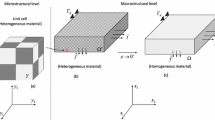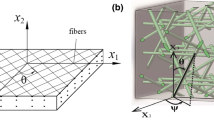Abstract
Bounds on the effective elastic moduli of a fiber-reinforced composite are studied. The composite is composed of infinitely long, parallel, equal-sized circular cylinders (fibers) randomly embedded in a matrix. Based on the variational principles and by employing the cylindrical inclusion solutions as trial functions, the bounds are determined through Monte Carlo simulations. Comparisons are made with the second-order and third-order perturbation bounds. Because the shape of the inclusion has been explicitly taken into consideration, it is found that the bounds computed by the present approach are the sharpest in terms of the width of the bound pair. Specifically, when the fibers are stiffer than the matrix, the present lower bounds coincide with the second-order lower bounds at low concentrations and are slightly higher than the second-order lower bounds at high concentrations, while the upper bounds are far below the corresponding second-order and third-order perturbation bounds. In many cases, the present bound pair is very close and thus provides accurate prediction on the effective properties of this class of composites.
Similar content being viewed by others
References
Hill R.: Theory of mechanical properties of fibre-strengthened materials-I elastic behavior. J. Mech. Phys. Solids. 12, 199–212 (1964)
Chiang C.R.: Bounds on the transverse effective conductivity of a fiber-reinforced composite. Int. J. Fract. 159, 93–100 (2009)
Peterson J.M., Hermans J.J.: The dielectric constants of nonconducting suspensions. J. Compos. Mater. 3, 338–354 (1969)
Tzadka U., Schulgasser K.: Effective properties of fiber-reinforced materials. J. Appl. Mech. 50, 828–834 (1983)
Ju J.W., Zhang X.D.: Micromechanics and effective transverse elastic moduli of composites with randomly located aligned circular fibers. Int. J. Solids. Struct. 35, 941–960 (1988)
Hill R.: Theory of mechanical properties of fibre-strengthened materials-III self-consistent model. J. Mech. Phys. Solids. 13, 189–198 (1965)
McLaughlin R.: A study of the differential scheme for composite materials. Int. J. Eng. Sci. 15, 237–244 (1977)
Spence A.: The transverse moduli of fibre-composite material. Compos. Sci. Technol. 27, 93–109 (1986)
Tandon G.P., Weng G.J.: Average stress in the matrix and effective moduli of randomly oriented composites. Compos. Sci. Technol. 27, 111–132 (1986)
Zhao Y.H., Weng G.J.: Effective elastic moduli of ribbon-reinforced composites. J. Appl. Mech. 57, 158–167 (1990)
Christensen R.M.: A critical evaluation for a class of micromechanics models. J. Mech. Phys. Solids. 38, 379–404 (1990)
Chiang C.R., Weng G.J.: A new look at Hill’s arithmetic and geometric means for a two-phase, isotropic composite. Acta Mechanica 156, 1–12 (2002)
Cherkaev A.V., Lurie K.A., Milton G.W.: Invariant properties of the stress in plane elasticity and equivalent classes of composites. Proc. R. Soc. Lond. A 438, 519–529 (1992)
Hu G.K., Weng G.J.: A new derivative on the shift property of effective elastic compliance for planar and three-dimensional composites. Proc. R. Soc. Lond. A 457, 1675–1684 (2001)
Hashin Z.: On elastic behavior of fiber reinforced materials of arbitrary transverse phase geometry. J. Mech. Phys. Solids 13, 119–134 (1965)
Beran M.J., Silnutzer N.: Effective electric, thermal and magnetic properties of fiber-reinforced materials. J. Compos. Mater 5, 246–249 (1971)
Milton G.W.: Bounds on elastic and transport properties of two-component composites. J. Mech. Phys. Solids 30, 177–191 (1982)
Torquato S., Lado F.: Improved bounds on effective elastic moduli of random arrays of cylinders. J. Appl. Mech. 59, 1–6 (1992)
Weng G.J.: Explicit evaluation of Willis’ bounds with ellipsoidal inclusions. Int. J. Eng. Sci. 30, 83–92 (1992)
McCoy J.J.: Bounds on the transverse effective conductivity of computer-generated fiber composites. J. Appl. Mech. 49, 319–326 (1982)
Goodier J.N.: Concentration of stress around spherical and cylindrical inclusions and flaws. J. Appl. Mech. 55, 39–44 (1933)
Cheney W., Kincaid D.: Numerical Mathematics and Computing. Brooks/Cole, Pacific Grove (1994)
Author information
Authors and Affiliations
Corresponding author
Rights and permissions
About this article
Cite this article
Chiang, CR. Computation of the bounds on the elastic moduli of a fiber-reinforced composite by Monte Carlo simulations. Acta Mech 217, 257–267 (2011). https://doi.org/10.1007/s00707-010-0390-x
Received:
Published:
Issue Date:
DOI: https://doi.org/10.1007/s00707-010-0390-x




